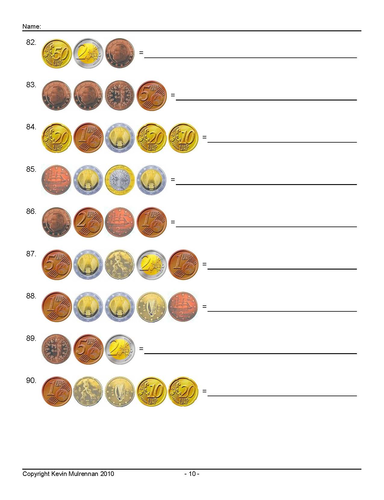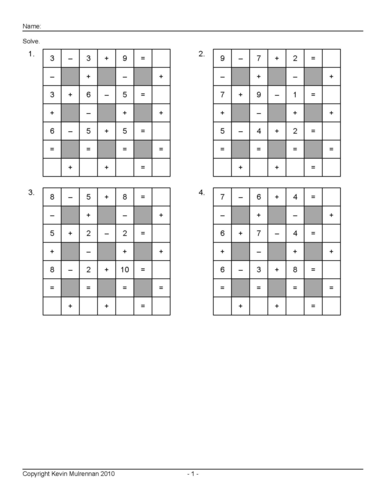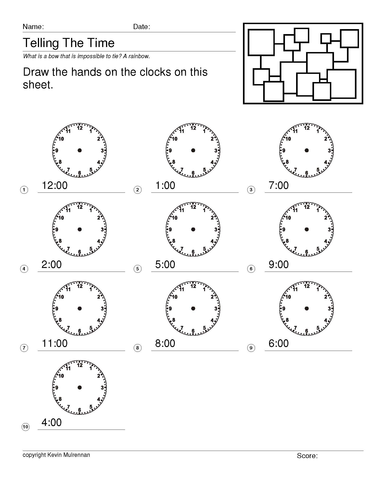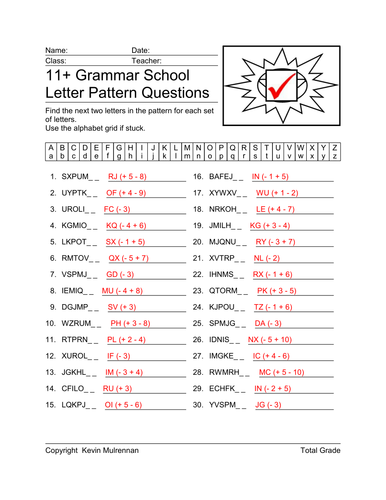421Uploads
152k+Views
49k+Downloads
Mathematics

Freebie Free 5 Worksheets Maths Shopping Arithmetic KS1 KS2 Money Counting
A freebie.
If you like these I have 100 for sale in my shop.
I have designed 5 worksheets on Money and Shopping for primary school children. I have used a variety of items, a variety of difficulty and a variety of numbers of questions per sheet. Pupils write on the sheets the total cost. e.g. a milkshake costs £2.90 a hot dog £1.65 How much would 2 milkshakes and 3 hotdogs cost? There is plenty there to reinforce the work done in the classroom. Good for extra homework or additional work for the bright ones. Answer sheets are provided for all worksheets.

Freebie Telling Time KS1 KS2 Mathematics Clocks Minutes Hours
A sheet where pupils have to put the correct times in.
If you like this, please visit my shop where you can buy a full set.

Euro Coins Worksheets KS1 KS2 Mathematics Freebie
A worksheet that pupils have to fill in. They have to add up the coins.
If you like it, please visit my shop that has an enhanced similar product.

Maths Puzzle Across Down Addition and Subtraction Puzzle Plus Answers
Great for reinforcing maths.
Across-Downs is a fun activity that reinforces addition and subtraction skills.
The object of the exercise set is to find the answer for each row and column, then use those answers to calculate the final answer in the lower right-hand corner of the puzzle.
This tests addition and subtraction.
If you like this freebie, please visit my shop which has loads of puzzles for sale. Buy the bundles for best value.

Freebie Fractions KS1 KS2 Mathematics Simplifying Mixed Fractions etc
An example freebie of my self-designed fractions sheets.
If you like this one, please take a look at my shop.
You could but half a million questions on fractions.
Or maybe ones on simplifying fractions, Mixed fractions etc.
Please look for the bundles if you are looking for great value.

Freebie Telling the Time KS1 KS2 Mathematics
A sheet with answers where pupils have to draw the hands to show the time on a small clock.
If you like this, please visit my shop where there is a more sophisticated product.

Table Drills Mathematics Multiplication KS1 KS2 Maths Freebie Free
If you like this resource more available in my shop.
Fill in the gaps to get the correct multiplication answer.

Number Sequences Maths 100 Worksheets with Answers
100 worksheets.
100 answer sheets.
At least 10 questions per sheet.
Pupils have to enter the next two numbers in the sequence.
They get harder so that later sheets include decimals and 20 questions per sheet.

Mixed Fractions Questions 100 Worksheets Maths
100 worksheets with answers.
Mixed fractions.
Some you have to multiply, some you have to divide etc.
A good time filler or revision homework.

Year 6 Maths Mean Median Mode Averages Range
A couple of nice lessons on these Maths topics.
Plus a little bit of spelling and formal and impersonal lessons.
sample:
LO: To state mathematical averages. (Hexagons and Pentagons)
For each of these questions, state the median, mode and mean average. Copy the data into your book. The layout is modelled in the first question.
MUST:
Maths Assessment Scores: 14 12 13 9 14 14
Mode:
Median:
Mean:
Football team Goals: 0 4 8 2 2 2 0 4 2 4
Visits to the seaside this year: 0 6 4 12 2 4 8 6 10 8
SHOULD:
4. Science Assessment Scores: 22 22 10 30 36
Hockey Team Goals: 3 6 12 0 0 0 9 12 10 6
Visits to Cinema in a year: 12 16 8 24 4 12 8 16 12 4
CHALLENGE
8. Spelling Scores: 6 7 9 2 4 5 0 4 1 2 6 5 5 5 8 9
Number in Family: 4 8 4 10 12 6 4 6 8 6 9 7
LO: To state mathematical averages. (Hexagons and Pentagons)
For each of these questions, state the median, mode and mean average. Copy the data into your book. The layout is modelled in the first question.
MUST:
. Maths Assessment Scores: 14 12 13 9 14 14
Mode:
Median:
Mean:

Maths year 6 12 Powerpoints 19 Word Files Time Area addition subtraction
12 Great powerpoints and associated word documents.
Ideal for entry into class or revision.
eaxample Order these integers from smallest to largest:
15, 9, 3, 108, 74, 203
93, 105, 99, 76, 54, 1, 205
3733, 408, 4080, 102, 97, 313, 537, 999.

Back to School Morning Resources Powerpoint Maths Year 4 Year 5
Some material that can be displayed on the board as they enter for registration.
7 to 10 simple questions per day
Two weeks worth.
sample ;
A school bag could weight about:
2 metres, 2 centimetres, 2 kilometres, or 2
kilograms?
The length of a bed measures about:
2 kilos, 2 metres 2 inches or 12 metres?
The height of a school building would be measured in:
centimetres, litres, kilometres, metres?
How many mms in 25cms?
How many strips of 10cm could you cut from 2 metres
of tape?
In the year 3 classroom there are 4 pots with 5 crayons
in each pot. How many crayons are there altogether?
Jodie thinks of a number and doubles it. The answer
is 30. What was the number Jodie thought of?
Double 7 and add 2.
Draw a square and shade ¾ of it.
A trip to the swimming baths costs 50p per child.
How much will it cost for 4 children?

Back to School Morning Resources Powerpoint Maths Year 4 Year 5 Set 2
Some material that can be displayed on the board as they enter for registration.
Powerpoint.
10 simple questions per day
Three weeks worth. Watermark not on full product
sample ;
Double 24.
Half of 28 is 14. What is ¼ of 28?
What is an apple likely to weigh:
1g, 10g, 100g, 1kg, 10kg?
A garden path is 10m long. Half of it is weeded, how
much is still to be weeded?
How many grams are there in 1kg?
How many 10’s are there in 265?
How many 100’s are there in 265?
Which of the following are even?
12, 9, 6, 14, 17, 5.
Read these numbers to your partner 562, 784, 90, 106.
Write these numbers in figures, two hundred and seven, six hundred and twenty six, fifty.

1000 Questions Advanced Addition Maths Mathematics KS2
1000 questions on advanced addition.
Pupils write the answers directly on the sheets. There are different numbers of digits that they can add up.
Answers all provided.

Back To School Autumn Short Term Lesson Plans Reception to Year 6
14 weeks of short term plans
Great for cutting and pasting into your own personal school timetable.
I’ve included a sample week in the visible upload. The zip contains the lot.
sample year 2. Register Activity
Chn finish work from Meet Your New Teacher day.
9am: Input: Welcome the children to their first day of year 2! Talk about how we were feeling before coming into school, did we get very much sleep last night? Share with the children how you were feeling too!
Introduce the chn to the text of the week: First day jitters by Julia Danneberg. Read the story together and discuss the twist at the end. (Ask questions throughout)
T focus for morning: x2 groups of 6
L.O. To use features of a non-chronological report
W.I.L.F
I can…
Include a heading
Use subheadings to organize my writing
Talk about the difference between facts and fiction
(All about me) Chn create a 3D profile, including a self-portrait drawing of their head, to be used for display. Chn complete section boxes all about their family, friends, hobbies etc. Cut out the sections and arrange them inside the folded top. Put together the body parts on colored backing card, ready for the head to be attached later. Label with name sticker.
9am: Input: Quickly recap the story for this week and remind ourselves of the main character, how she was feeling and why?
Introduce class bear, explain that he was also feeling very nervous about meeting new chn and starting year 2. Display a page from (bear’s) diary, ask the chn to highlight the adjectives they can see. (perform an action when they hear an adjective word)
T to highlight them in a colour as they read.
Explain the independent challenge is to match up the adjective words to the different emotion cards.
T focus for morning: x2 groups of 6
L.O. To use adjectives
W.I.L.F
I can…
Use capital letters and full stops
Use first person
Use commas between adjectives
Check my sentences make sense
(Writing it in the present tense) Chn to write a short diary entry about how they were feeling the night before they came back to school, include adjectives to describe how you were feeling.
*Have Monday’s 3D profiles out on a table to finish off.
TA focus for first thing: To assess SPP chn against current targets, make notes and set up folders for works to begin.

1000 questions Equations Single Variable Mathematics KS2 Algebra
1000 questions with answers on Equations.
Single variables.
Pupils have to work out what y equals.

11+ Verbal Reasoning Questions Letter Patterns Vol 2
Another 100 worksheets on volume 2. I've included more questions per sheet and for some I have omitted the alphabet grid. I have designed 100 worksheets on letter patterns for the 11+ non verbal reasoning questions. There are 100 worksheets provided on a cd. Letter patterns is an important aspect of the 11+ exams. Ideal for parents, pupils and tutors. Answer sheets provided. Introduce some logic and problem solving skills to students with the Letter Patterns worksheet. Sets of letters related in some way are displayed. Students must find the next two letters in the pattern for each set of letters. You can see an answer sheet in my picture with the answers in red.

Year 4 English Maths planning kr Short and Medium
Collected together my year 4 lesson planning from outstanding academy.
Mainly English and Maths.
sample:
Tuesday 31.01.12
LO: To understand how the use of expressive and descriptive language can create effects or generate emotional responses.
Read a descriptive/emotive poem ( Poems Not To Missed)
JBA & JP to model how to express how the poem made us feel and what impact the vocabulary choices had on us and why?
Read two poems that are expressive and descriptive.
Ask chn What was your immediate reaction? Which vocabulary choices were effective and had impact? Why? What emotions do you get from the poems? What images did you get from the poems?
Wednesday 01.02.12LO: To plan an ICT-based poetry presentation that involves each member of the group
Recap leaning - What are they learning? What have they learnt about poetry texts? Why is learning about poetry important? How could you use what you have learnt about performing poetry?
Inform chn that they are going to plan a poetry presentation. Discuss What is a poetry presentation? What is the purpose of a poetry presentation? How are poetry presentation put together?
Explain that they are going to promote a poem using key language/emotions from the poem.
In talk partners discuss what makes ‘good’ poetry? JP/JBA to scribe chn ideas on ‘working wall’
Using visual Literacy watch clips from poetry readings that the chn have watched previously. Ask:
What makes the poem a ‘good’ poem and why? Can you identify key language/emotions/rhythm in the poem that would entice others to read the poem and why? How would you go about putting the key language/emotions together to create a poetry presentation? JP/JBA to scribe chn ideas on ‘working wall’
JBA & JP model how we plan to put together a poetry presentation for a poem we have read. Explain that a presentation is to demonstrate the understanding of a poems’ key message.
Show what we are thinking when planning a poetry presentation. Which parts of the poems’ language was effective? What was the most emotional verses and why? Which verse has rhythm? How could we present this poem through drama? Thought shower ideas on working wall.

Year 1 Maths English Planning
Planning for English and Maths. 56 files.
sample:
Text:
This is the bear and the scary night
Genres covered in this unit:
Narrative SPAG focus:
Monday: spelling patterns
Tuesday: use and to join clauses
Wednesday: high frequency words
Thursday: high frequency words
Friday: time connectives
Key teaching input/texts/questions/
clips etc Steps to Success
Read the story This is the Bear and the scary night
Discuss character, setting, key events etc…
Discuss what happened in the beginning, middle and end of the story. Explain to the children that this week they are going to write their own story similar to the bear and the scary night.
Ask children to describe their character to their partner (can be their favourite toy or the teddy they bought into school on Friday).
Ask children to share their ideas about their story.
What is the setting?
What are the characters doing?
What is the problem?
How are the characters feeling?
How does your story end?
Mild: describe your main character
Spicy: share your ideas with your partner
Hot: listen attentively to your partner
Extra Hot: Act out key events from your story
LA Activities MA Activities HA Activities
Read to Write
Mrs Preston Phonics
Mrs Simpson Talk for writing and act out their story
Photos for books
Resources: The bear and the scary night book, cards with questions
Give 3 minutes for children to recap their story.
Who is their main character?
What happens at the beginning, middle and end of the story?
Model how to put key ideas onto their plan.
Steps to Success
Mild: recap your story with your partner
Spicy: Identify the beginning, middle and end of your story
Hot: Write key ideas onto your story plan for the beginning, middle and end.
Extra Hot: Check your partner’s plan is sequenced correctly

Year 6 English Maths Planning Gunpowder Plot
Lots of planning for all three terms.
Maths and English mainly but arts stuff and History too.
sampl:
Text: The Gunpowder Plot
Genres covered in this unit:
• Predictions
• Inference (How? Why?)
• Newspaper features
• Journalistic writing
• Letter writing
Key teaching input/texts/questions/
clips etc
BOOKS
Display an image from the front cover of the book and discuss what children already know. What does it look? What do you think will happen? What can you see in the picture? Share and discuss, make notes for working wall.
Show children the entire cover of the book. Identify the 5Ws; who? What? Where? When? Why? What is the title? What do you think will happen? Note 5ws for working wall.
Show children the grid for likes, similarities and puzzles, Identify one for each section and explain why I chose it.
Whole class discussion of extra hot challenge.
Resources:
Book cover
Images from book cover
Grid sheet
JOTTERS
Review previous learning – refer to working wall. What do you think will happen? Who will be involved? Where will it happen? Why does it happen? When does it take place? Share predictions.
Introduce the text to the children. Read first 4 pages and ask questions linked to the text.
Children to read through/skim read to identify the 5Ws – record for the working wall and compare with predictions. Was anyone close with their prediction? Why might this be?
Share video with children: https://www.youtube.com/watch?v=YptNONmnXH0 Discuss key events. What do you think will happen next? Make predictions in jotters and share.




















